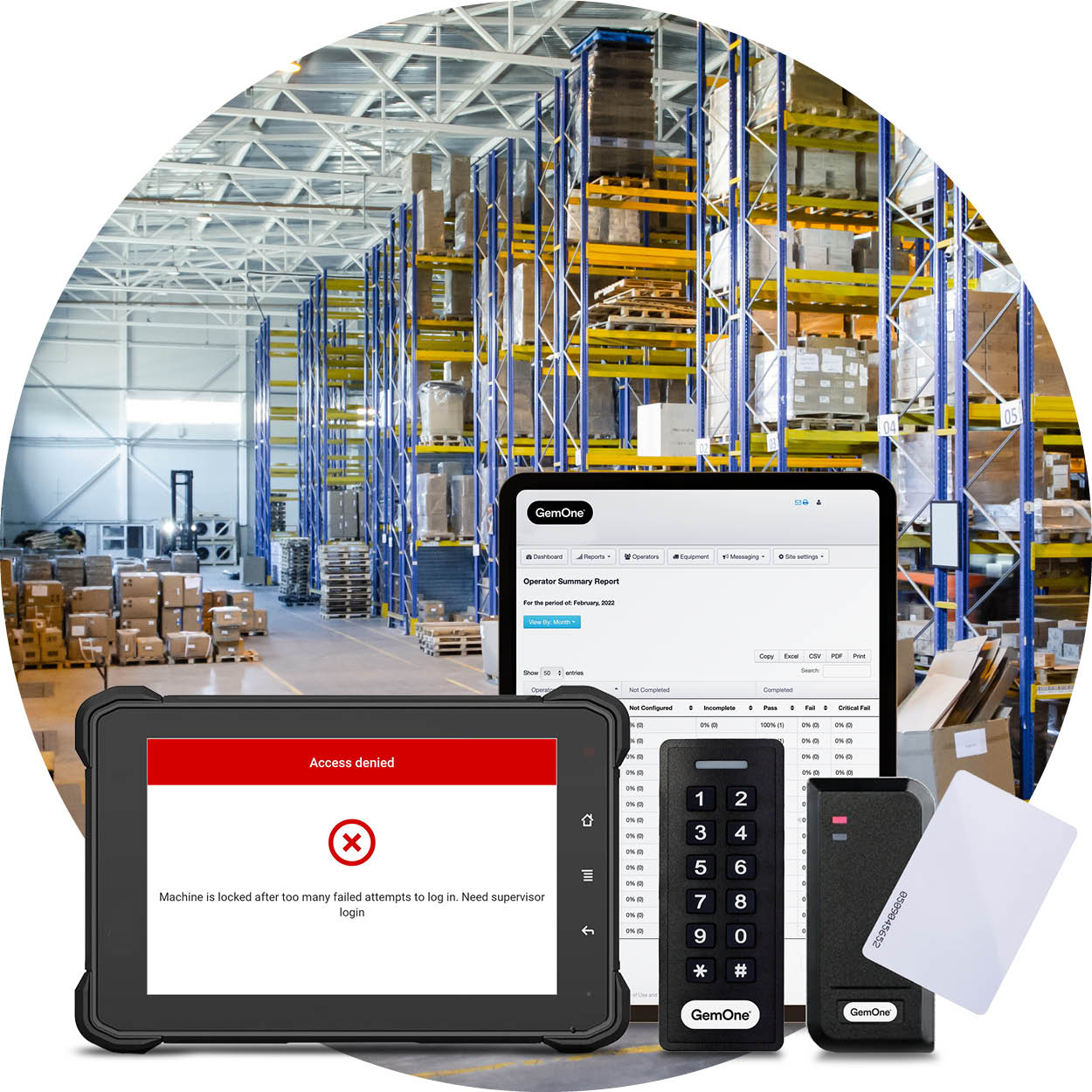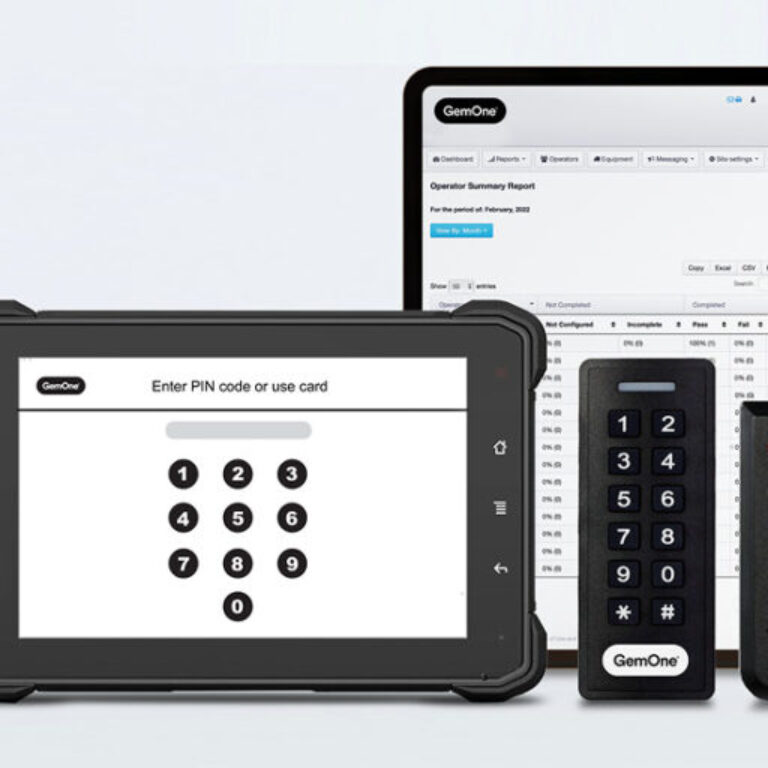The Benefits of Operator Access Control for Fleet Management
- Equipment rental
- Fleet efficiency
- Fleet management
- Material handling
- Security and safety
In the world of material handling and warehousing, unauthorised machine usage can lead to significant safety concerns and operational inefficiencies.
According to data (2022) compiled by the Occupational Safety & Health Administration, forklift accidents cause around 85 deaths each year in the USA, in addition to causing about 35,000 serious injuries and 62,000 non-serious injuries annually. And according to the health and safety regulator, 70% of forklift injuries could be avoided with better training policies. (OSHA)
In the UK it was reported that around 1,300 employees are hospitalised each year with serious injuries following forklift accidents (British Safety Council)
While the Australian Institute of Health and Safety released a report from Worksafe, who reported 142 claims where the cause of injury was a forklift incident, with the transport, postal and warehousing industry accounting for the most claims (45), followed by manufacturing (35) and wholesale trade (32). More than half of these claims were from forklift operators.
The most common incidents included pedestrians being hit by forklifts, with 26 serious injury claims accepted in 2022. While in the past four years, eight people have died as a result of forklift incidents in the workplace.

What is Operator Access Control?
Operator Access Control is a feature of fleet management tools which ends the risks involved in the unauthorised usage of industrial machines in your fleet.
A growing number of fleet and warehouse managers recognise that Operator Access Control is a crucial tool in helping them create a safer workspace and ensuring that their machines are being operated safely and efficiently.

Operator Access Control is a crucial feature in various industries – particularly those industries where powered industrial vehicles and heavy machinery play a significant role.
Access control ensures that only authorised and certified individuals can operate specific equipment, enhancing operational security and safety.
This technology is essential in sectors such as material handling, construction, manufacturing, warehousing and logistics, where it not only prevents unauthorised access but also helps in maintaining compliance with operator certifications and training requirements.
Access control systems provide an additional layer of protection and accountability in these high-risk environments, mitigating the potential for accidents and improving overall operational efficiency.
How does Operator Access Control Work?
With Operator Access Control, you give access to your machines to approved operators only.
Whether it’s a pin code, RFID card, or fob, you decide who operates each machine based on specific certifications and training criteria.
Machine operators receive a unique ID number or RFID card that allows them to access only the equipment they are authorised to operate.
Through Operator Access Control, authorised personnel gain exclusive access to designated machinery. This access is granted using various methods such as pin codes, RFID cards, or fobs, tailored to the operator’s certifications and training level.
Each operator is assigned a distinct identification number or RFID card, which serves as their access key. Importantly, an operator can hold multiple access keys, each tied to a specific machine or set of machines. However, an access key remains exclusive to a single operator and cannot be shared or reassigned.
Operators may assume different roles, such as operator, technician, or supervisor, and can be associated with one or more machines accordingly. Notably, when an operator is linked to a specific machine, all of their access keys become applicable to that asset.
It’s important to note that access keys are not directly assigned to machines; instead, they are issued to operators, ensuring a granular and controlled approach to machine accessibility. This comprehensive system facilitates precise control over equipment operation while accommodating operators with diverse responsibilities and granting access only to those with the necessary qualifications.

Operator Access Control is an invaluable tool for enhancing safety and operational efficiency in a warehouse setting. By restricting access to unauthorised users, it significantly reduces the risk of accidents caused by untrained or unqualified operators.
This not only ensures a safer work environment but also helps maintain compliance with OSHA certifications and national safety requirements. Furthermore, the system allows for precise tracking of machine access, providing a valuable safety management tool through an online Cloud portal.
By guaranteeing that only qualified users operate the equipment, you not only reduce the risk of incidents but also stay in alignment with insurance policies, safeguarding your operations and workforce.
Configuration and Types of Access
Access control for the operator is a multifaceted system that ensures safety and compliance within a warehouse. It can be configured in various ways, using either a PIN code, an RFID card, or a combination of both. These methods serve as authentication tools, and without proper authentication, the machinery remains immobile, preventing unapproved usage.
Access assignment within this system can follow various models such as discretionary, role-based, or attribute-based, depending on specific requirements. Operators can have multiple access keys, which can be assigned to them individually. These keys are not directly assigned to the machines but are linked to the operator’s profile.

Here’s how each access type works:
RFID (Radio-Frequency Identification):
RFID cards are physical cards containing a unique identification code. They are assigned to operators and act as a means of authentication. When an operator with the RFID card attempts to start or move a machine, the system reads the card’s code and, if it matches, grants access.
PIN (Personal Identification Number):
PIN codes are numerical sequences that serve as personal identification numbers for operators. They are entered by the operator to authenticate themselves. Proper entry of the PIN code is necessary to activate the machine.
Badge (Sticker on Badge):
Badges can be equipped with RFID technology, essentially combining the RFID card and badge functionalities. The sticker on the badge contains the RFID code, which, when scanned, serves as authentication.
This comprehensive access control system ensures that only authorised, trained, and qualified personnel can operate machinery, promoting safety, compliance, and streamlined operations within the warehouse.

Every warehouse is unique.
We know that Operator Access Control features should be fully customisable to suit your specific business needs.
Recognising that every warehouse possesses its own distinctive layout, operational processes, and security concerns, the flexibility of Operator Access Control becomes a valuable asset.
By harnessing the power of customisation, you gain the ability to finely tune access criteria to match the unique demands of your warehouse. Whether your business mandates varying levels of operator expertise or necessitates differentiated equipment access for different roles, the customisation feature empowers you to establish access protocols that precisely align with your needs.
Moreover, the capacity to set up lockout thresholds through customisation adds an additional layer of security to your operations. By defining specific criteria that trigger automatic lockouts or alerts, you can proactively mitigate potential risks and safeguard sensitive machinery from unauthorised or potentially hazardous use.
Learn More
If you’re interested in learning more about Operator Access Control and other fleet management features, download our free Sapphire brochure here.
Top articles






